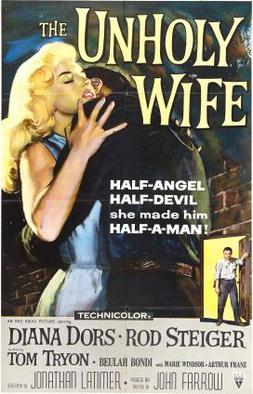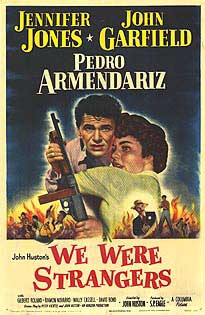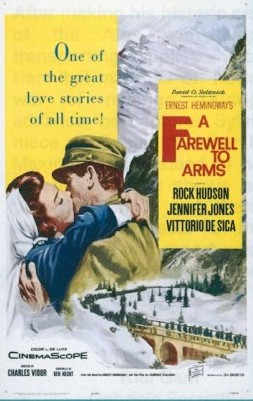
Bad Day at Black Rock is a 1955 American film noir neo-Western film directed by John Sturges with screenplay by Millard Kaufman. It stars Spencer Tracy and Robert Ryan with support from Anne Francis, Dean Jagger, Walter Brennan, John Ericson, Ernest Borgnine and Lee Marvin. The film is a crime drama set in 1945 that contains elements of the revisionist Western genre. In the plot, a one-armed stranger (Tracy) comes to a small desert town and uncovers an evil secret that has corrupted the entire community.

Heaven Knows, Mr. Allison is a 1957 American CinemaScope war film directed by John Huston. It stars Deborah Kerr as an Irish nun and Robert Mitchum as a U.S. Marine, both stranded on a Japanese-occupied island in the Pacific Ocean during World War II.

William Lee Tracy was an American stage, film, and television actor. He is known foremost for his portrayals between the late 1920s and 1940s of fast-talking, wisecracking news reporters, press agents, lawyers, and salesmen. From 1949 to 1954, he was also featured in the weekly radio and television versions of the series Martin Kane: Private Eye, as well as starring as the newspaper columnist Lee Cochran in the 1958–1959 British-American crime drama New York Confidential. Later, in 1964, he was nominated for an Academy Award for Best Supporting Actor and a Golden Globe for his supporting role in the film The Best Man.

The Killers is a 1946 American film noir directed by Robert Siodmak and starring Burt Lancaster in his film debut, along with Ava Gardner, Edmond O'Brien and Sam Levene. Based in part on the 1927 short story of the same name by Ernest Hemingway, it focuses on an insurance detective's investigation into the execution by two professional killers of a former boxer who was unresistant to his own murder. The screenplay was written by Anthony Veiller, with uncredited contributions by John Huston and Richard Brooks.

Impact is a 1949 American film noir drama film starring Brian Donlevy and Ella Raines. Directed by Arthur Lubin, it was shot entirely in Northern California, including scenes in Sausalito at Larkspur in Marin County, on Nob Hill in San Francisco, and throughout the Bay area. The screenplay was based on a story by film noir writer Jay Dratler. Charles Coburn, Helen Walker, Anna May Wong, Philip Ahn, and William Wright appear in support.

Nobody Lives Forever is a 1946 American crime film noir directed by Jean Negulesco and based on the novel I Wasn't Born Yesterday by W. R. Burnett. It stars John Garfield and Geraldine Fitzgerald and features Walter Brennan, Faye Emerson, George Coulouris and George Tobias.

The Unholy Wife is a 1957 Technicolor film noir crime film produced and directed by John Farrow at RKO Radio Pictures, but released by Universal Pictures as RKO was in the process of ceasing its film activities. The film features Diana Dors, Rod Steiger, Tom Tryon and Beulah Bondi. The screenplay was written by William Durkee and Jonathan Latimer

3:10 to Yuma is a 1957 American Western film directed by Delmer Daves and starring Glenn Ford and Van Heflin. Based on a 1953 short story of the same name by Elmore Leonard, the plot concerns an impoverished rancher who takes on the risky job of escorting a notorious outlaw to justice.

State of the Union is a 1948 American drama film directed by Frank Capra about a man's desire to run for the nomination as the Republican candidate for President, and the machinations of those around him. The New York Times described it as "a slick piece of screen satire...sharper in its knife-edged slicing at the hides of pachyderm schemers and connivers than was the original." The film was written by Myles Connolly and Anthony Veiller and was based on the 1945 Russel Crouse, Howard Lindsay Pulitzer Prize-winning play of the same name.

The Maltese Falcon is a 1941 American film noir written and directed by John Huston in his directorial debut. Based on the 1930 novel The Maltese Falcon by Dashiell Hammett, it is a remake of the 1931 film of the same name.

The Las Vegas Story is a 1952 American suspense film noir starring Jane Russell and Victor Mature, directed by Robert Stevenson and produced by Robert Sparks and Howard Hughes with Samuel Bischoff as the executive producer.

Yellow Sky is a 1948 American Western film directed by William A. Wellman and starring Gregory Peck, Richard Widmark, and Anne Baxter. The story is believed to be loosely adapted from William Shakespeare's The Tempest. The screenplay concerns a band of reprobate outlaws who flee after a bank robbery and encounter an old man and his granddaughter in a ghost town.

In This Our Life is a 1942 American drama film, the second to be directed by John Huston. The screenplay by Howard Koch is based on the 1941 Pulitzer Prize-winning novel of the same title by Ellen Glasgow. The cast included the established stars Bette Davis and Olivia de Havilland as sisters and rivals in romance and life. Raoul Walsh also worked as director, taking over when Huston was called away for a war assignment after the United States entered World War II, but he was uncredited. This film was the third of six films that de Havilland and Davis starred in together.

The Terror of Tiny Town is a 1938 American musical Western film produced by Jed Buell, directed by Sam Newfield and starring Billy Curtis. The film was shot at a sound studio in Hollywood and partly at Placeritos Ranch in Placerita Canyon, California. The inspiration came when Buell overheard an employee jokingly say "If this economic dive keeps going, we'll be using midgets as actors".

Three Strangers is a 1946 American film noir crime drama directed by Jean Negulesco and starring Sydney Greenstreet, Geraldine Fitzgerald, and Peter Lorre, and featuring Joan Lorring and Alan Napier. The screenplay was written by John Huston and Howard Koch. It was produced and distributed by Warner Brothers.

We Were Strangers is a 1949 American adventure drama film directed by John Huston and starring Jennifer Jones and John Garfield. Set in 1933, the film concerns a group of revolutionaries attempting to overthrow the Cuban government of Gerardo Machado. The story is based loosely on an episode in Robert Sylvester's novel Rough Sketch and draws on historical events.

A Farewell to Arms is a 1957 American epic war drama film directed by Charles Vidor. The screenplay by Ben Hecht, based in part on a 1930 play by Laurence Stallings, was the second feature-film adaptation of Ernest Hemingway's 1929 semiautobiographical novel of the same name. It was the last film produced by David O. Selznick.
Danger Signal is a 1945 American film noir starring Faye Emerson and Zachary Scott. The screenplay was adapted from the 1939 novel of the same name by Phyllis Bottome.

Wanted! Jane Turner is a 1936 American crime drama film directed by Edward Killy from a screenplay by Edmund L. Hartmann and John Twist, based on Twist's story. Produced by RKO Radio Pictures, the film premiered in New York City on November 27, 1936, with a national release the following week on December 4. The film stars Lee Tracy and Gloria Stuart with an extensive supporting cast.

Danger Patrol is a 1937 American drama film directed by Lew Landers from a screenplay by Sy Bartlett based on a story by Helen Vreeland and Hilda Vincent. Produced and distributed by RKO Radio Pictures, it was released on December 3, 1937, and stars Sally Eilers, John Beal, and Harry Carey.


















